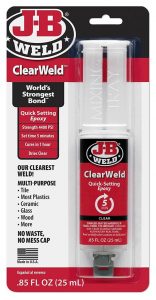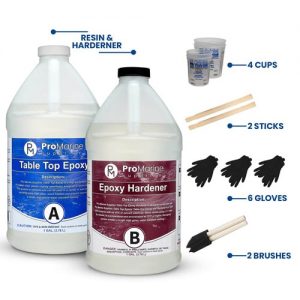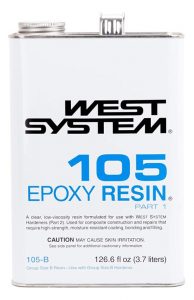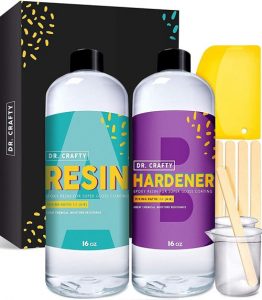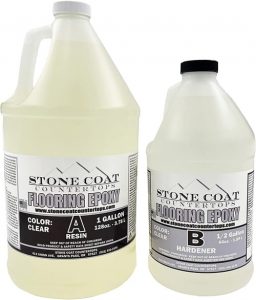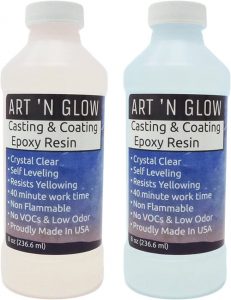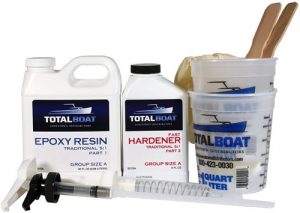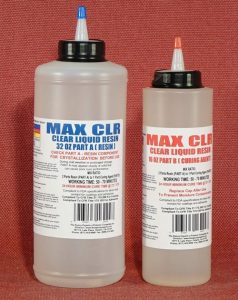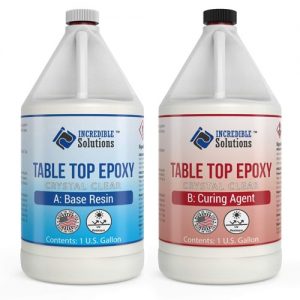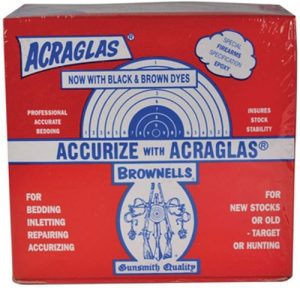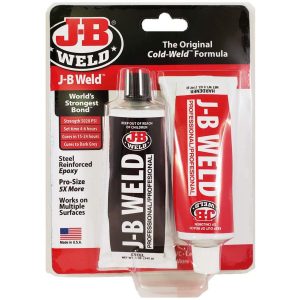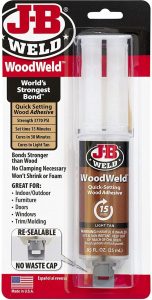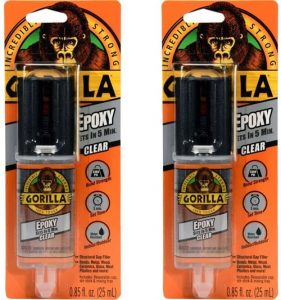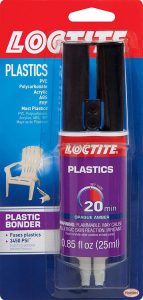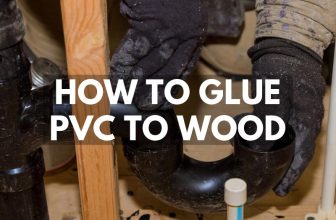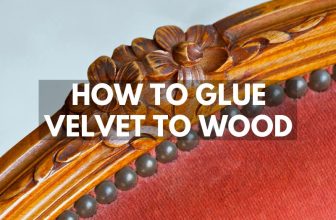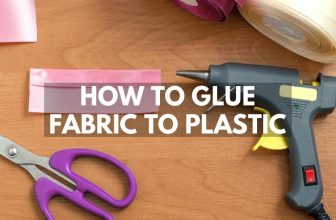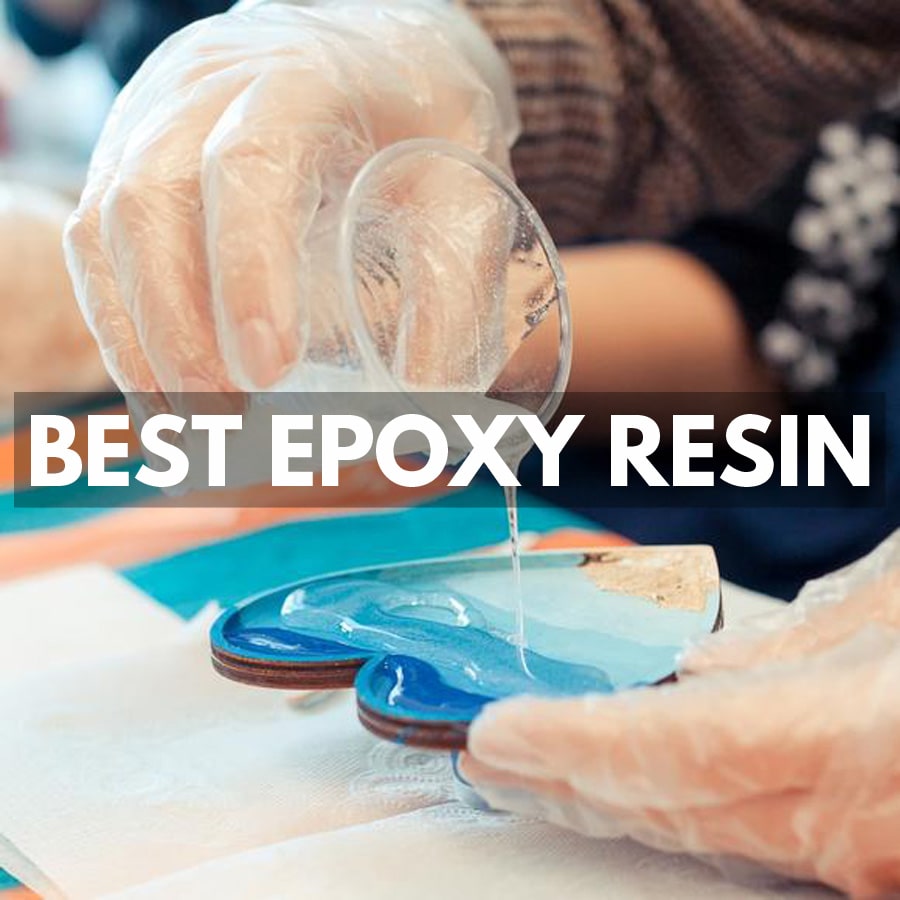
In this guide to the best epoxy resin, we explain which epoxy resin will work best for your application and surface material. We teach you step-by-step how to select the right type of epoxy adhesive for your project, how to mix it, how to apply it, and how long it will take to set.
Understanding which type of epoxy to use for your specific task can be hard if you’ve never used it before. There is an epoxy resin available for just about any kind of project you can think of with dozens of brands claiming to be the strongest or fastest to set.
In this epoxy resin guide, you will learn the different types of epoxy and when to use them, and on what. We help you to understand the process from start to finish and save you from making a permanent error.
Depending on your project, you might only need a small amount of epoxy or you might need a large amount for river tables or for flooring. The most important things to consider other than the quantity are the working time, setting time, and pouring thickness of your epoxy.
Finding the Best Epoxy Resin for Your Project
What is Epoxy Resin?
Epoxy resin is a two-part glue that requires equal measures of resin and hardener to be mixed together to activate its adhesive properties. It is available as a liquid or solid putty and can be used on metal, wood, plastic, ceramic, glass, tile, concrete, PVC, fiberglass, and lots of other materials.
Epoxy is a family of polyepoxides that are classed as reactive prepolymers and polymers that contain epoxides. Epoxy resins are activated through catalytic photopolymerization with a reactant, also known as a hardener or curative.
The reaction forms a thermosetting polymer which creates an extremely strong bond that is resistant to thermal and chemical extremes. This makes epoxy resin one of the most useful industrial and commercial adhesives available today.
Top 3 Best Multipurpose Epoxy Resins
In a hurry? These are the top 3 best epoxy resins we recommend for general DIY and craft purposes. They can be used on most materials and form an unbreakable bond that is stronger than steel or any wood.
1. JB-Weld ClearWeld Quick-Setting Epoxy

JB-Weld ClearWeld is one of the most well-known brands of epoxy resin and they have a wide range of products for different projects. If you only need a small amount of epoxy then we would highly recommend the JB- Weld syringe which is practical and easy to use.
The syringe applicator allows you to mix and apply the resin in one go without any messy mixing or need for a brush. You can use it on just about anything and it creates as strong a bond as you will find anywhere.
2. Pro Marine Supplies Crystal Clear Table Top Epoxy Resin & Hardener

Pro Marine Supplies Crystal Clear Table Top Epoxy Resin is ideal for projects that require a lot of adhesives to cover a large surface area. The 2-gallon kit is perfect for creating a waterproof coating or finish to worktops, flooring, furniture, and even boats. It is also a general-purpose epoxy adhesive that can be used for DIY, crafts, and bonding almost any two surfaces together.
It has a maximum pour depth of 1/8″ which means it isn’t designed for making deep tables or sculpting crafts but for everything else, it has you covered. The kit includes everything you need to mix and apply the glue and has a curing time of 24 hours. Pro Marine Crystal Clear Epoxy is UV resistant which means that, unlike other Epoxies, it won’t yellow over time.
3. West System Epoxy Resin

West System Epoxy Resin is unique in that it is the base formula for epoxy resin but can be combined with multiple hardeners to achieve results specific to your task. These different hardeners include allowing you to get the best results when you want fast set time, crystal clear finishes, or slow cure time.
If you use epoxy resin fairly regularly this is a good choice because it can be modified to achieve the result you want. It is suitable for all your bonding needs as well as for a coating and is ideal for crafting because it is so easily blended with color pigments and other additives.
Best River Table Epoxy Resin
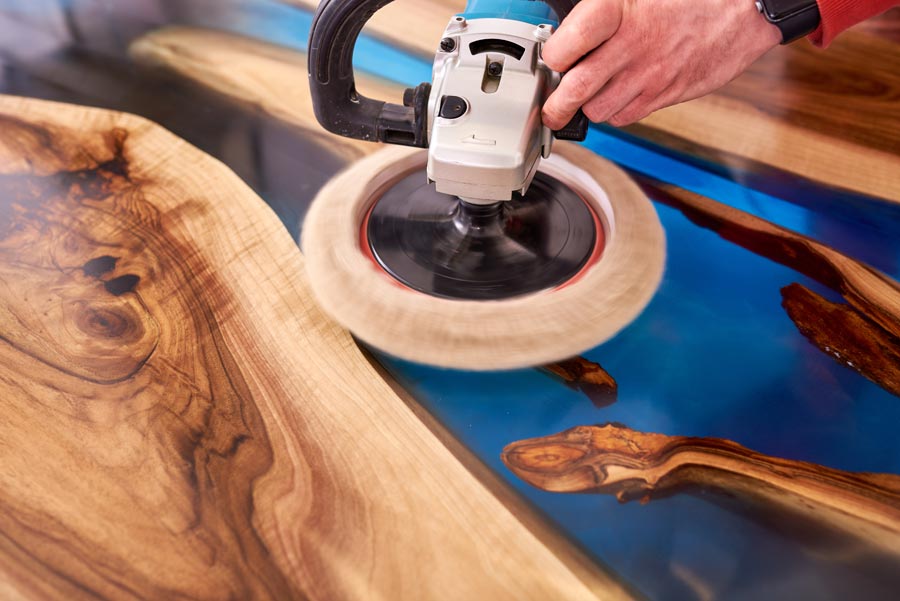
The best epoxy resin for making river tables is a deep pour clear casting resin that can be pored up to 2″ thick and be colored to your taste. You can add dyes, pigments, and other ingredients to create your desired color and texture for some amazing results.
You will need a large amount of resin for most river tables. To work out how much you need, do an experiment with water first and measure the amount it takes to fill the void.
Preparation is the key to success when it comes to any kind of epoxy-based project as it can be very unforgiving once the chemical reaction has begun. You will need to make sure you have enough epoxy for the pieces of wood you have selected so that you can pour it all in one go.
Pourable Plastic Deep Pour Casting Resin

Pourable Plastic Deep Pour Casting Resin is what we recommend for anyone trying to create a river table. It is has a low viscosity and exothermic reaction which enables longer working times and minimal shrinkage so that it doesn’t damage the wood.
The beginner-friendly formula sets rock solid and crystal clear which is why most professionals also choose this brand. With a 2:1 mixing ratio, you don’t need as much hardener to create 0.75 gallons of finished epoxy. It is low odor and food safe for use in kitchens and worktops as well as mixing very well with pigments for vibrant finishes that look like an ocean.
Best Epoxy for Resin Arts and Crafts
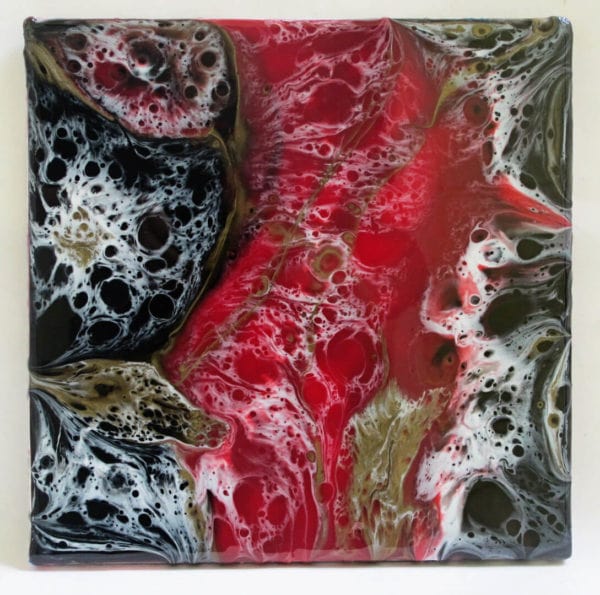
When using epoxy resin for arts and crafts you need to make sure you are getting the right type of epoxy for the material you are using. Whether you are using epoxy to simply fix things together or are using it as a decorative element, choosing the best type of epoxy for crafts and art can make or break your project.
Thicker resins that are crystal clear are the best to work with for most crafts because they allow you to add color and other elements without being too runny. Epoxy resins with a thinner consistency tend to absorb the colors too quickly which prevents the nice textures and patterns they can create.
Naked Fusion Epoxy Resin Crystal Clear Formula

Naked Fusion Epoxy Resin Crystal Clear Formula is our favorite resin for arts and craft because of its high gloss and mirror shine. It also combines with pigments, pastes, alcohol inks incredibly well to produce ultra-vivid and luminescent artwork.
It works for casting, coatings, and fixings with a rock-solid finish and has a 45 minute working time so you don’t have to rush your creativity. It has zero VOCs, is BPA free, is UV resistant, and is self-leveling, and doesn’t bubble as some epoxies do.
Best Jewelry Epoxy Resin

To create unique jewelry from epoxy resin you need to use the clearest and glossiest epoxy to give the impression of a gemstone. Another factor to consider is the UV resistance which will prevent the jewelry from yellowing in the sun.
Pour depth is not so important when using silicone molds but you should check the work and cure time to make sure it works to your schedule. Watch out for bubbles and a cloudy finish with some cheaper epoxy kits and the harder it sets the better.
DR CRAFTY Clear Epoxy Resin

DR CRAFTY Clear Epoxy Resin is the preferred epoxy resin used by professionals for making jewelry. It sets crystal clear and has a glossy finish which means that it polishes up very nicely and looks magnificent when mixed with color pigments.
You have 45 minutes of working time once mixed and it sets rock hard with no bubbles in around 24 hours. This is perfect for use on surfaces like burnt wood or with delicate objects like flowers to make rings, necklaces, and charms. Compared with other jewelry resins, we think this produces the best end result with the least flaws.
Best Flooring Epoxy Resin
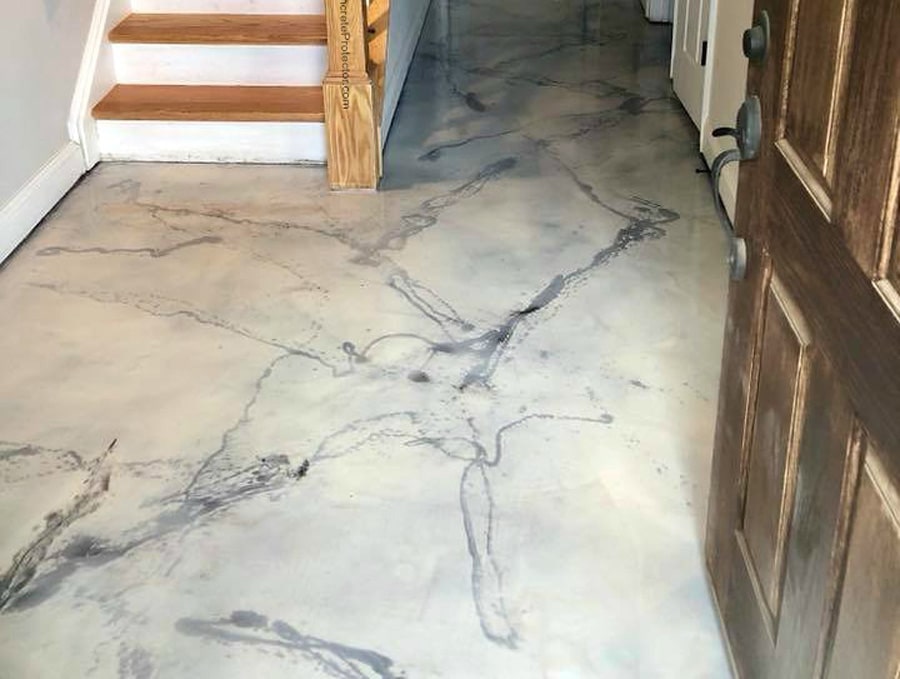
Epoxy Resin can be used to create some amazingly creative floor surfaces when combined with inks or pigments. You can recreate marble patterns or go for something way more ‘out there’. It is also a great way to create a waterproof and highly resistant floor for places like your garage or workshop.
The most common way to use epoxy resin on the floor of an older house is as a protective coating to preserve your expensive solid wood flooring. You can pour a thin layer of epoxy over your parquet flooring and preserve the craftsmen’s ship indefinitely. If using general epoxy for floor coating, make sure it is self-leveling to get a high-quality finish.
Stone Coat Countertops Flooring Epoxy

Stone Coat Countertops Flooring Epoxy is one of the few epoxy resins designed especially for flooring and is incredibly low cost compared to other options. The kit makes 1.5 gallons of epoxy resin which is enough to cover 10 square feet of flooring.
The floor epoxy will be dry in 10 to 12 hours but should be left for 24 hours before walking on it and 72 hours before driving on it. With a glossy finish that can be altered with additives, the set surface is slip-resistant, waterproof, heat resistant, UV resistant, scratch-resistant, and nontoxic for safety at home.
Best Casting Epoxy Resin
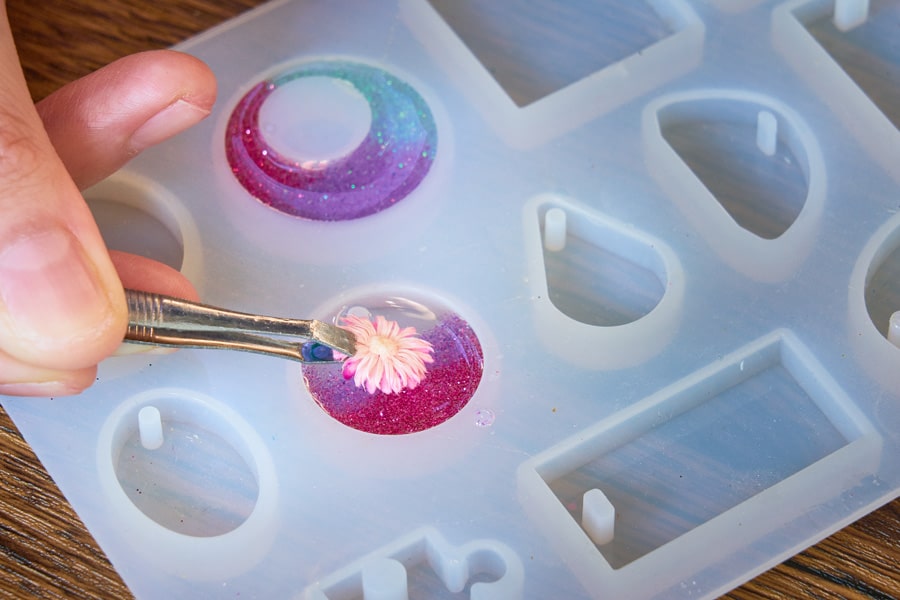
The type of epoxy resin that is best for making castings is crystal clear and self-leveling with as little bubbling as possible. Jewelry epoxy often works very well for small projects but for larger castings, you should look for a deep pour casting epoxy.
Casting epoxy will typically have a longer working and curing time with a lower exothermic reaction which allows for deeper casting pours. They will have a thinner viscosity which is better for pouring and allows the mix to have a set level at the top.
Art ‘N Glow Clear Casting and Coating Epoxy Resin

Art ‘N Glow Clear Casting and Coating Epoxy Resin is ideal for creating your own castings in latex molds. It has a very clear and thin consistency for around 45 minutes before it starts to gel up which is plenty of time to pour multiple castings.
It is self-leveling so you shouldn’t get any rough or lipped edges but if you do, it polishes up nicely after being worked. You can create some amazing paperweights and casts by mixing the epoxy with glitter, pigments, paints, chalk, natural elements, and even kitchen spices.
Best Epoxy for Boats
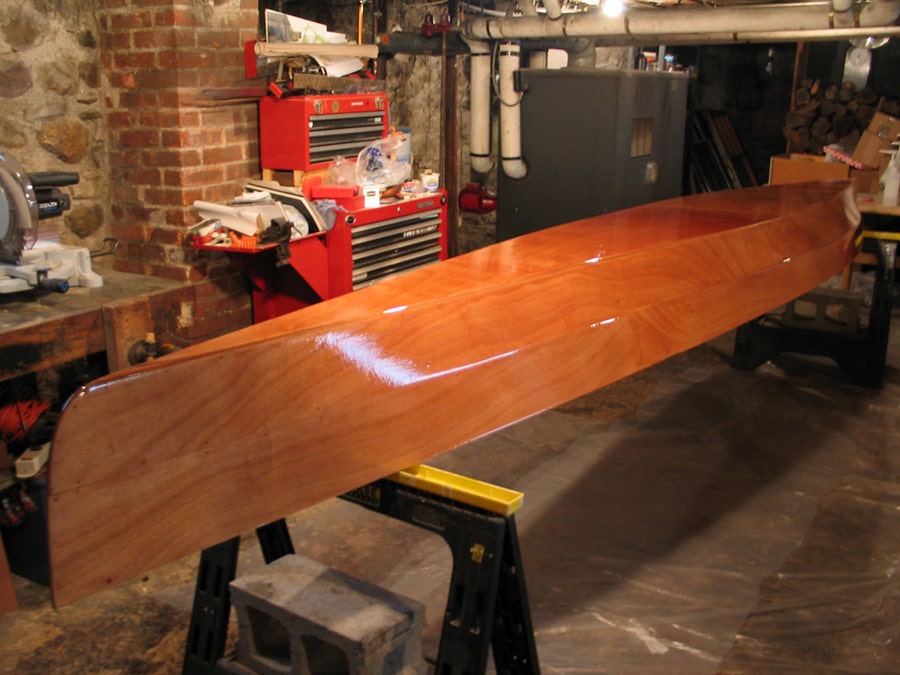
Marine Epoxy can be used both for repairs and for protection. For small repairs, you can use a small liquid mix of epoxy and hardener. For small holes in your vessel, you can use a thicker epoxy resin putty or paste as a plug. For all surface coatings and waterproofing, you will need a larger amount like the one we recommend below.
TotalBoat 5:1 Marine Grade Epoxy

TotalBoat 5:1 Epoxy Marine Grade Epoxy comes with all the kits you need to finish fiberglass and wooden boats. Included in the kit are two measured pumps so that you only have to press 1 pump of each for a 5 to 1 mix ratio. This glue is not crystal clear and does yellow slightly over time so it is not something I would use on the dash.
You can wet out fiberglass cloth and reinforcement materials into a fixed position within 12 to 20 minutes depending on whether you choose the fast or slow hardening solution. There are lots of different types of epoxy that you can use on a boat, canoe, or kayak but we found this was one of the toughest for seafaring vessels.
Best Tumbler Epoxy Resin

Custom-made epoxy tumblers have become the new trend and people are making good money selling them online. You can use spray paint and clear epoxy or you can mix colors into your epoxy for one-of-a-kind designs.
Make sure the epoxy you use is heat resistant and FDA approved if you plan to sell your tumblers online. You can learn how to make them here if you don’t already know how but we recommend a stronger resin than the one they use in the link.
MAX CLR Food Safe FDA Compliant Epoxy Resin

MAX CLR Food Safe FDA Compliant Epoxy Resin is one of the safest resins to use on surfaces that are in contact with food and drink. It is heat resistant and is extremely durable so it doesn’t damage or chip like other more brittle epoxies.
It is perfect for mixing with alcohol inks or color pigments as well as additives like glitter and imagery. If you are interested in making epoxy tumblers then we recommend you start with MAX CLR which is easy to work with and has a long setting time of around 1 hour.
Best Countertop Epoxy Resin

If you are thinking of installing a new worktop then stop what you are doing and explore the idea of an epoxy countertop. You can create an epoxy kitchen counter by simply pouring over your existing one. You can add colors or patterns to mimic marble or just stick with a solid color for a clean look.
Epoxy is the perfect countertop material because it is so hardwearing and easy to apply an extra thin layer if you aver want to touch it up. You can use epoxy countertops next to heat because of their high resistance and they are one of the cheapest ways to change your kitchen vibes up a bit.
Incredible Solutions Table Top Epoxy Resin

Incredible Solutions Table Top Epoxy Resin is the best for table tops, bars, and work surfaces with proven results over many years. When used as a protective layer you get a glossy finish and crystal clear clarity that really highlights the beauty in old wooden countertops.
It is food safe and UV-resistant which is ideal for kitchen worktop protective epoxy which may get some sun throughout the day. Colors mix into the solution really easily for custom designs and tones which is why we think this is such a great product.
Best Epoxy For Plastic Bumper Repair
If you damage your car bumper and are looking for a quick and easy DIY fix, using epoxy resin is very effective and a fraction of the cost of a new bumper. Bumper damage is typically a crack that needs to be glued back together and there is no stronger adhesive than epoxy.
To fix your cracked car bumper with epoxy you simply mix the resin and hardener together and apply a small amount down the length of the crack. Make sure both pieces are in the correct position and clamp if needed. Leave this for 24 hours and you will hardly be able to tell the difference.
PC Products PC-AutoBond Epoxy Adhesive Paste

PC Products PC-AutoBond Epoxy Adhesive Paste is the perfect epoxy for car bumpers as it is so thick and easily bonds to auto bodies. It comes in a conveniently packaged syringe that mixes the resin with the hardener to start the exothermic reaction. This is completely safe to use on metal, plastic, fiberglass, and even rubber.
The end product is black which is very discreet on standard bumpers but you will have to apply it on the inside for cars with matching color bumpers. This epoxy is so easy to use, anyone can fix their cracked bumpers without ever stepping foot in a mechanics or car garage.
Best Knife Handle Epoxy Resin
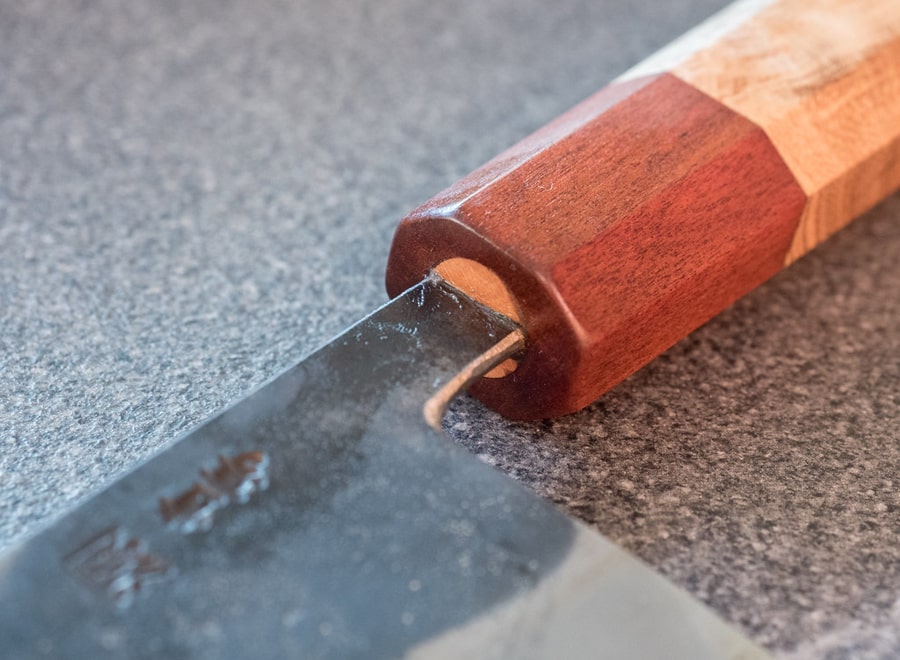
Knife handles are subjected to a lot of stress, wear, and tear. Because knives are can be dangerous if not constructed safely, it is super important to use a reliable epoxy when attaching the handles.
The two most popular knife handle epoxies are West Systems G/Flex and Acraglas Rifle Barrel Beddin but having used Acraglas for many years, they claim the top spot.
Acraglas Rifle Barrel Beddin

Acraglas Rifle Barrel Beddin is the best epoxy for knife handles and securing scales to your knife tang. It is designed to be used on rifles and guns and so is also ideal for knife handles that need a lot of impact resistance and strength.
It has the perfect viscosity to soak deep into any cracks or gaps to strengthen the handle and hold your blade in position. This is the epoxy of choice for gunsmiths, blacksmiths, and knife makers alike, and for good reason.
Best Epoxy for Metal
When it comes to bonding metal with epoxy resin, there is a special blend that works particularly well. This is steel reinforced epoxy and as the name suggests, the formula includes a strengthening additive that replicates the characteristics of the metal. Metal epoxy is often in a thick past form due to the steel additives and is best applied with some kind of spatula.
JB WELD Original Steel Reinforced Epoxy

JB WELD Original Steel Reinforced Epoxy is well known for being one of the strongest epoxy resins for joining metal aka ‘cold welding’. It creates a high tensile strength of over 5000 PSI and is temperature tested up to 550° F which means you can use this on machinery as well as fires and ovens.
I believe the steel is powdered into the epoxy so that when the hardener is added, the steel strengthens and reinforces the chemical bonds that form. This makes sense as to why it creates such a strong bond when used on metal.
Best Epoxy for Wood

Choosing the best wood epoxy depends on your project but for most small jobs you can safely use a syringe applicator to avoid messy mixing pots. Epoxy works notoriously well on all types of wood and so is an easy choice for DIY repairs and fixings. It is always best to prepare the wooden surface before application to avoid bubbles and get a tidy finish.
J-B Weld WoodWeld Epoxy Syringe

J-B Weld WoodWeld Epoxy Syringe is especially good for solid wood as well as for wood that is either degrading or starting to rot. It helps to stabilize the surface without taking away from the wood’s natural character.
The good thing about JB Weld WoodWeld is that it has a tan color to match the surface of most woods and be less visible on repairs. As well as the syringe applicator you can also get a tube form and putty stick depending on what you need it for.
Best Epoxy Resin for Glass
Clear epoxy resin is the ideal type of glue for glass because you can get crystal clear results, with a super strong hold that is more flexible than superglue. There are lots of options to choose from but we find that most of them are the same so we recommend using one of the big brand names that are tried and tested.
Gorilla Glue Clear Epoxy

Gorilla Glue Clear Epoxy is a staple of most DIY and craft stores around the world and it happens to be one of the best for glass. Whether you are fixing glass to another material or gluing two pieces of glass together, this will give you one of the cleanest finishes and strongest bonds.
Because glass is transparent you don’t want to use glue that has any color in it and won’t yellow in the sun. Gorilla Glue Clear Epoxy is safe to use inside or outside and has a 6 minute set time for rapid fixing.
Best Epoxy for Plastic
When it comes to plastic epoxy you have the choice between a reactive epoxy and a non-reactive epoxy. Reactive epoxy causes a chemical reaction within the plastic to fuse it with the epoxy. A non-reactive version simply bonds to the plastic like a normal glue or adhesive. If its plastic that you are specifically trying to bond to then we would recommend a reactive epoxy for the added strength.
Loctite Epoxy Plastic Bonder

Loctite Epoxy Plastic Bonder is our go-to resin adhesive when bonding any kind of plastic together. It works on nylon, polycarbonate, Mylar, PVC, Acrylic, ABS, and many other types of plastic to make it the best all-round plastic epoxy.
Loctite Plastic Bonder has a 20 minute set time without any shrinkage or expansion which helps when it is fusing the plastic together. Being resistant to high temperature, moisture, impact, solvents, gasoline, and other chemicals means you can use this on any kind of plastic application.
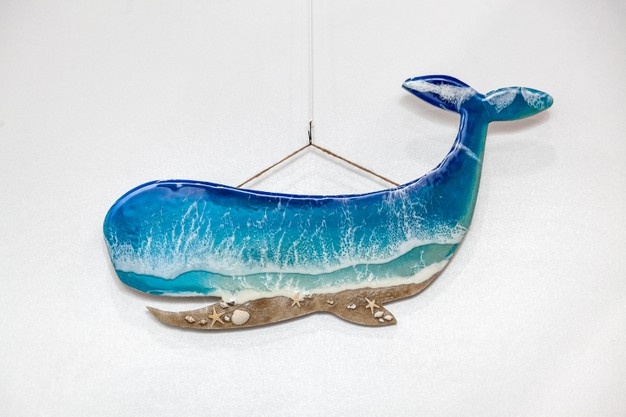
Things to Consider When Buying Epoxy Resin
When looking for the right epoxy resin for your project there are quite a few different considerations to take into account. Some projects may require a quick fix while others will benefit from being left to harden for days. Here are the factors we consider when looking for the right type of epoxy resin to work with.
Working Time
With two-part epoxy, once you combine the hardener with the resin you only have a small window of time to work with the glue and apply it to everywhere it needs it. This may be 5 minutes or it might be over an hour depending on the type of epoxy and the ratio of hardener to resin. Make sure the resin you choose gives you enough time to work with it and only mix small amounts at a time.
Set Time
The set time will then occur anywhere from a couple of hours to 24 hours again depending n the type of epoxy and the mix ratio. This is when the glue has become immovable to the touch but is fully set in position. During the setting period, you may have to use some kind of clamp to keep things in position.
Cure Time
The cure time is the amount of time it takes for an epoxy resin to reach its maximum strength and the chemical reaction between the hardener and resin has finished. You may have to wait days if making river tables for example as deep pours take longer to fully cure.
Viscosity
The viscosity of epoxy resin describes the internal friction of a moving fluid or in other terms, how thick or runny something is. Thinner viscosity epoxies are runnier than a thicker viscosity resin and they both have their uses. Most epoxies sit somewhere in the middle of the spectrum but obviously thicken up as they start to set.
Color
You may want to add color to your epoxy in which case you need to look for a crystal clear option that will display the added colors to their fullest potential. Many epoxies will have a natural yellow tint that develops over time and is exaggerated under UV light. You can avoid this by using clear epoxy with UV protection.
Clarity
Some epoxy resins are clearer than others which is important for crafts like jewelry making and castings. Once you start looking around on forums and question boards you can see that some brands have much clearer formulas than others and there is a little bit of technique involved too.
UV Resistance
UV resistance will prevent clear epoxy from tuning a yellowish color in the sun. This matters for outdoor applications and if you have used any epoxy on the glass in your windows. Most epoxies will have this in their product descriptions if it is something they support.
Pour Depth
Some epoxy resin is not meant to be poured beyond a depth of 1/8″ because they have a high exothermic reaction and become too volatile with deeper pours. If the exothermic reaction is too great it can permanently damage any adjoining materials and warp the whole shape. Be sure to get a deep pour epoxy if you plan to make a river table.
Food Safe
If you plan to use your epoxy anywhere near food like a worktop, chopping board, or tumbler art then you should look for something that is food safe and ideally FDA approved. Check out our recommendation for the best tumbler art epoxy above for an extremely food-safe epoxy.
Self-Leveling
What is self-leveling epoxy resin? The words ‘self-leveling describes how a liquid epoxy will spread out over a surface to provide a level finish regardless of what is underneath. It will fill cracks and adjust to bumpy surfaces to provide a glossy top that is smooth and flat.
Flexibility
Some tasks will require some flexibility in the joint or fixing and so a flexible epoxy can be used to increase shock absorption and minimize stress impact. Standard two-part epoxy often sets rock hard and can be quite brittle and so a modified epoxy with extra flex will be the best option.
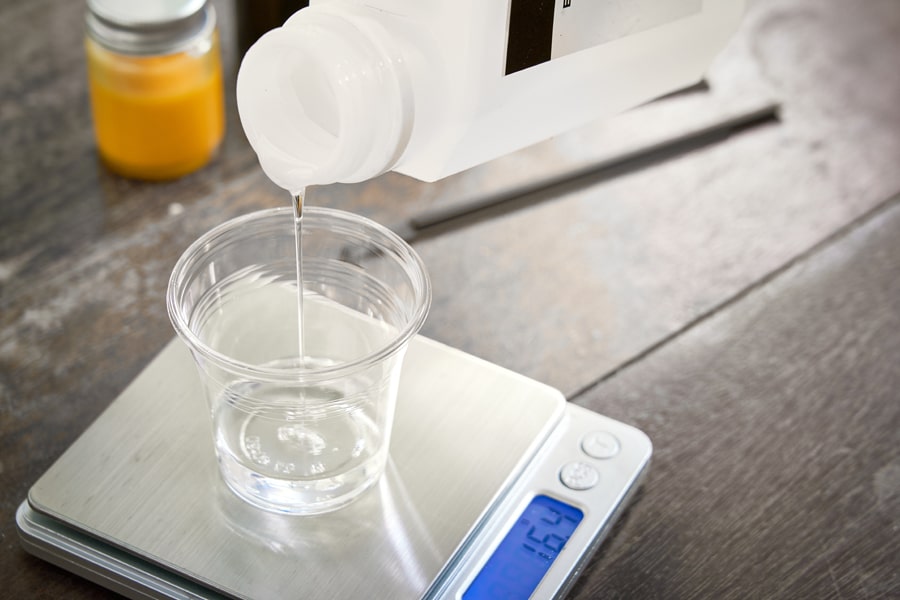
Things to Avoid When Using Epoxy Resin
Whenever you are using epoxy resin, there is always a risk that something will go wrong. Mistakes happen and so do accidents. To minimize the chances of making a mess or ending up with poor results you should make sure you are as prepared as you can be before you mix your epoxy. Here are some common issues you may face and how to avoid them.
Excessive Stirring
Stirring your epoxy mix too much or too aggressively will create bubbles that aren’t good for strength or appearance. Stir your two-part epoxy mix slowly and once it is sufficiently merged stop stirring and get ready to pour. The more you stir the faster the exothermic reaction will happen and the less working time you will have.
Greasy or Oily Surfaces
Epoxy resin and greasy/oily surfaces don’t mix. For the epoxy to make a good bond with the surface material it needs to be clean and free of any grease and oil. You may have to use acetone to remove any oil and grease residue and in some cases sand the top layer off to reveal a workable surface.
Rushing
Preparation is key with epoxy resin project as you only have a set amount of time to use two-part epoxy once it has been mixed. You should have everything ready before you start including protective clothing and a safe working area so that once you mix your epoxy you are ready to use it. Epoxy is permanent so just take your time and make a plan before you start.
Mixing Too Much Epoxy
Mixing the right amount of epoxy is important to avoid any wastage and also to prevent an accelerated exothermic reaction. If you mix too much hardener and resin it can start to gel up very quickly and makes getting an even coverage much harder. To understand how much epoxy you need, use water to measure the volume and then match it.
This guide to the best epoxy resin has hopefully covered everything you need to know but feel free to get in touch with any questions.

